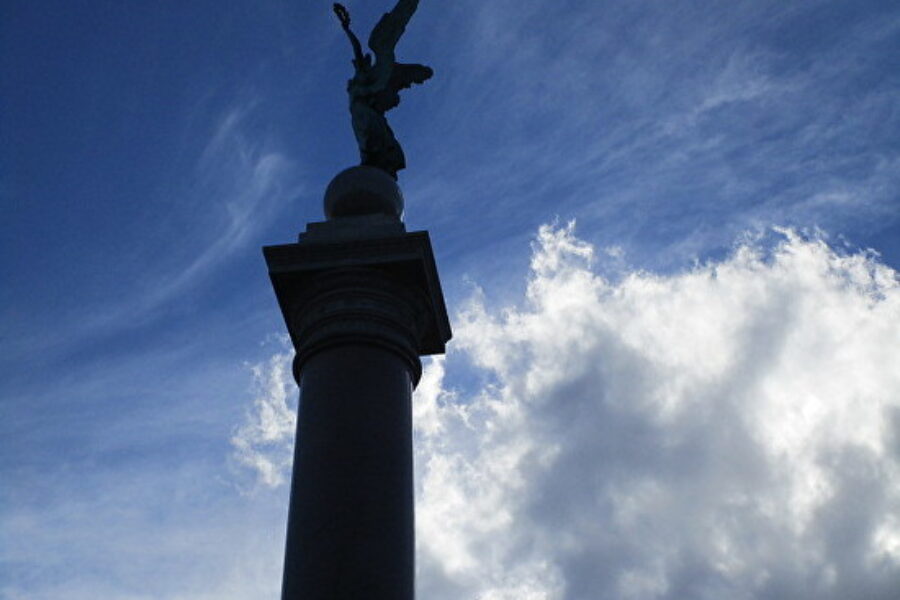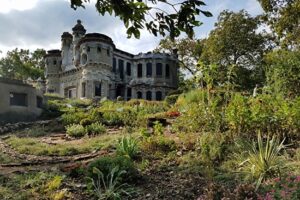Newburgh
Racing south on 84, we get off at the last tollway exit before West Point. As Michael continues to drive toward Newburgh, he suggests I find a place to have lunch on the water. My phone tells me there are three. I pick the first on the list, Blu Pointe, which doesn’t open for another thirty minutes.
We explore, looking for Trinity, the large church where Michael’s great-great-grandfather’s funeral was held, and where he also preached part-time. He warns me, “The area it’s in isn’t the greatest.” He has walked these streets on Google Earth.
The church is somber and imposing. The neighborhood is torn and tattered, looking like broken dreams and lost hope. It leaves me feeling sad and a lot guilty for having all that we do. Living in our perfect Hill Country hide-a-way, I forget that places like this exist. And this town has a population of approximately 30,000. What do bigger cities look like?


Lunch at Blue Pointe
Lunch on the water is a different world. Stepping from the car onto the parking lot pavement, the day feels balmy and warm. We ask to sit outside. The terrace is sheltered; the view is of blue water, bluer mountains, and blue skies. And a tour boat. It calls Michael’s name, but it doesn’t fit in with our POD. The boat will have to wait for another day.
Today’s lunch is wonderful. I try to be good and order only water to drink. But then, thinking about what I am having for lunch, I decide, I really do need a glass of prosecco.


Our flatbread appetizer is so-o-o-o-o good. I have to take a picture of the last bite to remember the ingredients: fig jam, goat cheese, a paper-thin slice of green apple, dressed arugula, a dusting of parmesan, and crispy bits of prosciutto, all layered on a crisp rectangle of flatbread. The flavors are lovely together. I want to try this at home—my home, home—not the home where I am currently staying.
Michael’s lobster roll is accompanied by the best French fries in the world, parmesan-truffle oil. I can’t help myself—I keep stealing one after another when he isn’t looking. Then I apologize and take another. They are a perfect foil to my tuna stack—avocado, ahi tuna, micro-greens, and a drizzle of mint oil. I could do this every day—all day. Perhaps I am a bon vivant. I wonder if that is a good thing. Probably not.


A West Point Tour
At West Point, we purchase tickets for the two-hour tour, which begins at 2:30 pm. That is more than an hour from now. We are pointed in the direction of the museum. The ticket agent tells us it is the best military museum in the states. I have seen different versions of what is before me all over the world. But this is the first time I have seen a replica of the casing that held the Fat Man A-bomb that devastated Nagasaki. We humans are a brutal, destructive race.






Our tour guide is a charming Englishman. I can’t help but wonder what led him to this place and this time and this avocation. We follow as he leads us on board the bus that will take us to the highpoints of this historic military academy. We listen to the story of the football rivalry between Army and Navy and learn how important McArthur felt sports are to the development of both the individual and team building. I have been reading From Here to Eternity—finally—and I now I understand the sports angle that seems unending and unbending.
There are stories to go with the austere old chapel, the numerous monuments in the cemetery, and all of the buildings and statues that surround the field where tomorrow’s officers learn to jump from a helicopter at three thousand feet and land on a yellow cross in the middle of green green grass.
The Chapel
A Gothic mass of soaring gray granite, Cadet Chapel, is an imposing medieval fortress on West Point’s grounds; the organ in the Chapel is the largest church organ in the world. I know Michael would love to hear the thunder of numerous pipes, but it is not to be.
“Duty, Honor, Country,” the academy’s motto, is inscribed on the massive window in the sanctuary. The names of Generals MacArthur, Taylor, and Westmoreland, along with others, are engraved on silver plates in the chapel’s first few pews. The interior is as imposing and elegant as the exterior. It makes me wonder how many young girls dream of walking down this aisle under an arch of silver swords to their handsome West Point groom.



The Cemetery
The West Point Cemetery holds within its gates memorials to some of America’s most storied military leaders and historical figures, including General Norman Schwarzkopf, Major General Daniel Butterfield, Lieutenant Colonel George Custer, and Margaret Corbin, along with other notable heroes, astronauts, and 18 Medal of Honor recipients.
“Well done; Be thou at peace.”





Civil War Monument
The site for the monument was dedicated in June 1864 by General George McClellan, who gave a lengthy address and stated, “The site of the Battle Monument is dedicated in commemoration of the Officers and Privates of the regular Army who have died in the present war.” He dedicated the site to “the memory of brave men, loyalty, patriotism, and honor.”
The monument itself was dedicated in May 1897 by surviving American Civil War veterans and was financed by monthly contributions from the pay of officers and soldiers of the Regular Army. Inscribed on bronze straps belting the eight monumental “cannonballs” circling the column are the names of 2,230 Regular Army officers and soldiers who died for the Union during the Civil War.


Parachute Jumping
The West Point Parachute Team was founded in 1958 and is currently composed of 36 cadets. To be selected, cadets go through an extensive tryout—interview, fitness test, and wind tunnel exercise—during their first year (plebe) at the academy. After earning their skydiver’s license, they make their first solo jump during what would ordinarily be considered a sophomore year or in West Point speak their yearling year. By the time they graduate, West Point Parachute Team cadets have made over 500 jumps. According to the team’s noncommissioned officer in charge, cadets on the parachute team reach a level of proficiency, practicing six days a week in two-and-a-half years, which takes civilian jumpers 10 to 15 years to master. And they are jumping one after another after another and hitting their mark.
The West Point Parachute Team’s mission is to educate, train, and inspire cadets to develop leadership skills and build self-confidence in extreme or dire circumstances. They work toward three specific and challenging goals: training freefall students, conducting precision freefall demonstrations, and competing and winning at the national level.





View from West Pointe


Leaving the Pointe, I ask Michael, “What are we doing tomorrow?”
“Nothing,” he replies.
At last. We haven’t done nothing for over thirty days.









Leave a Reply
Your email is safe with us.